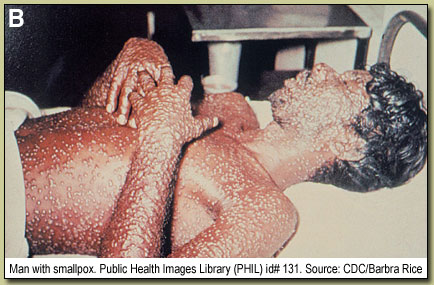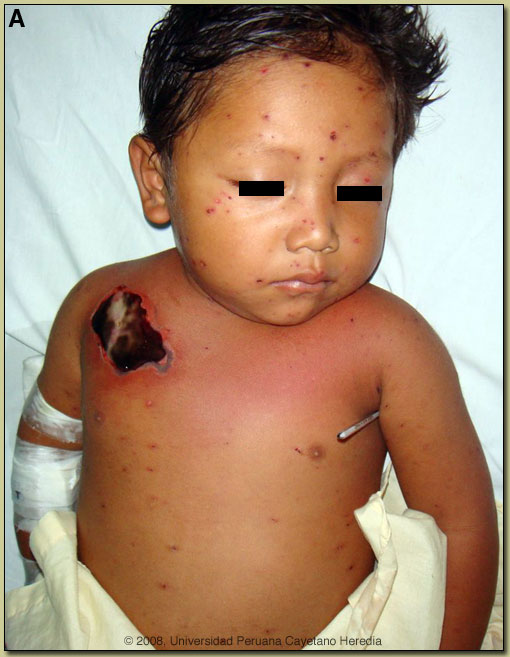| 2008 Case #9 |  |
|
| Diagnosis: Acute varicella infection (Chickenpox) complicated by necrotizing cellulitis likely due to group A streptococcal infection. |
 Discussion: Acute Varicella Zoster Virus (VZV) infection is a clinical diagnosis with a characteristic vesicular rash of the superficial dermis involving the trunk, face, and oropharynx. Notably, several crops of fresh vesicles may erupt every few days, becoming crusted and lasting for a total of 6-10 days. In contrast, the lesions of smallpox [Image B] begin on the extremities with all lesions occurring at the same time and appearing and evolving in a similar manner. The incubation period of varicella is 10-21 days, most commonly about 14 days. Both the brother and cousin also had acute varicella. Discussion: Acute Varicella Zoster Virus (VZV) infection is a clinical diagnosis with a characteristic vesicular rash of the superficial dermis involving the trunk, face, and oropharynx. Notably, several crops of fresh vesicles may erupt every few days, becoming crusted and lasting for a total of 6-10 days. In contrast, the lesions of smallpox [Image B] begin on the extremities with all lesions occurring at the same time and appearing and evolving in a similar manner. The incubation period of varicella is 10-21 days, most commonly about 14 days. Both the brother and cousin also had acute varicella.
In the tropics, including in developing countries, the age distribution of acute varicella differs markedly from that in temperate climates. Only the minority of individuals acquire varicella in childhood, so that many adults remain non-immune and clinical varicella in adults is common. In temperate climates only 2% of varicella cases occur in those over 20 years of age. In the US and Europe, varicella outbreaks in immigrant and refugee communities are increasingly frequent events. The reasons for the altered behavior of VZV virus in the tropics have not been elucidated. Complications of varicella are more common in adults, especially varicella pneumonia, which occurs in up to 20% of adult cases. Pneumonia in pregnant women is more severe though perhaps not more frequent than in other adults. Pneumonia usually develops in the first week of rash onset and pregnant women should be followed closely for the onset of respiratory symptoms. Invasive group A streptococcal infections with necrotizing fascitis are now established as a not infrequent complication in children with primary varicella. A number of outbreaks and case series have been reported. In one study, after controlling for age, gender, and group A streptococcal isolation, cases were more likely than controls to have used ibuprofen [Pediatrics. 1999 Apr;103(4 Pt 1):783-90], as in the current case, and there are several other similar reports from the 1990s. However, another prospective case-control study failed to show a causal effect of NSAIDs [Pediatrics. 2001 May;107(5):1108-15], so the association remains controversial. The benefit of acyclovir in acute varicella in children under the age of 12 is modest at best and is not routinely recommended in authoritative guidelines. The patient was treated with IV clindamycin and oxacillin with marked improvement. A consultation with a surgeon was made for proper debridement of the necrotic scar.
|
|
During the past week the Gorgas Course in Clinical Tropical Medicine concluded with a 4-day field trip to Iquitos on the banks of the Amazon River. Iquitos, with a population of approximately 500,000, is the largest city in the world that is reachable only by air and by river. The nearest road ends over 400 km away. Publishing a case report every week for 9 consecutive weeks would not be possible without the assistance of an extremely dedicated group of people. We would like to thank in particular: Dr. Carlos Seas, Clinical Rounds Coordinator for the Gorgas Courses for case selection, coordination of case summaries and images; and Adam Plier of the Gorgas Center for Geographic Medicine of the UAB Division of Infectious Diseases for all publishing on the Gorgas Course web site. We hope you have enjoyed this year’s cases. In August 2008 we will be running the 2-week Gorgas Expert Course and will present a couple more cases during that time. We will also be in touch in January 2009 at the beginning of next year’s case series. |
